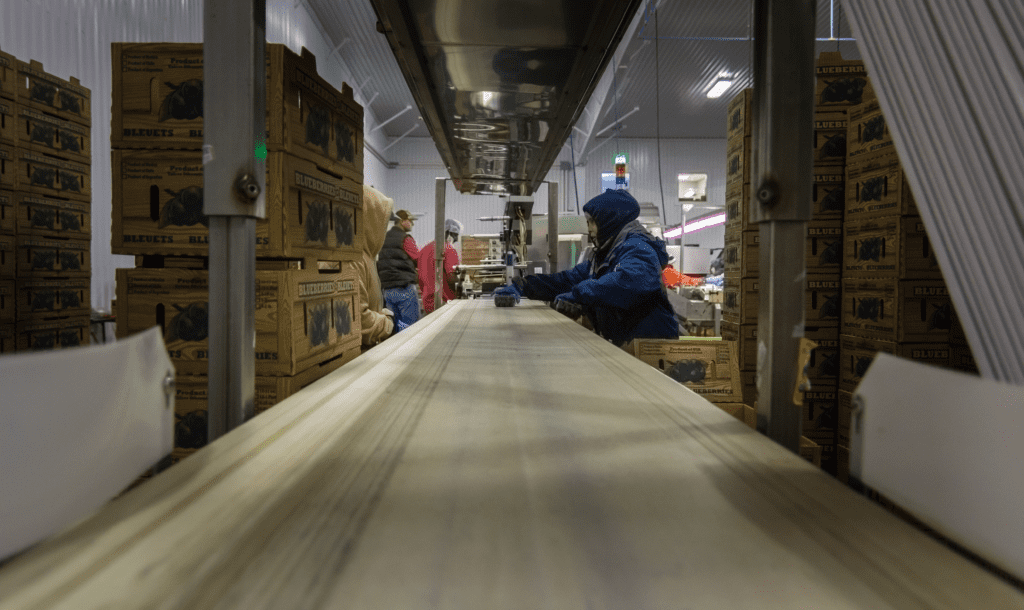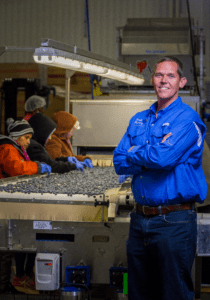Florida Blueberry Growers Vying with Competitors for Lucrative Spring Marketing Window
AS FLORIDA’S BLUEBERRY industry matures, increased competition is making it harder for growers to realize dreams of blue gold. “I think there’s going to be a bit of a shakeout in the blueberry business going forward,” asserts Ryan Atwood, a blueberry grower with about 40 acres in Umatilla and Dade City.
Florida’s blueberry growers produced between 18 million and 20 million pounds of blueberries this season according to industry estimates, up from some 13 million to 14 million pounds in 2016, a dismal year. Dudley Calfee, the president of the Florida Blueberry Growers Association, notes that the climax for the Florida season was met concurrently by a late freeze in Georgia, which damaged crops. “Our hearts go out to our brother farmers in Georgia,” he says. “Hopefully, they had crop insurance.” Subsequently, the Florida growers maintained a little bit higher prices for the harvest.
Michael Hill, Atwood’s partner in H&A Farms packinghouse and Florida Ag Care in Mount Dora, says this year was great, but he’s concerned about the future. “Mexico is currently producing before and at the same time we are,” he points out.
The 2017 season had bright spots, and challenges. “This year, sentiment is up. If it wouldn’t have been for that freeze [in Georgia], I think people would really be crying the blues in the blueberry world,” says Atwood, an FBGA board member, blueberry consultant, and farm manager. He describes the season as probably the longest one in 12 years.
In the end, some growers were planning to sell some acreage. “I want to stay in it. I’m trying to do what I can to keep at it,” says Andy Frederick, who has nearly 100 acres in Silver Springs, Lithia, and Arcadia. “It’s definitely an uphill battle.” He plans to sell his 30 acres in Lithia, either to scale back or build up his more modernized Arcadia farm.
Yancey’s Blueberry Farm in Silver Springs, which he bought in 1999, is feeling the pinch because of newer u-pick operations across the state. Robert White Yancey’s farm opened in 1960 and began selling u-pick blueberries to tourists and people from across Florida in 1966.
“It’s getting a lot more challenging than I’d like. It’s hard to get labor,” adds Larry Davis, a blueberry grower for 20 years who is trying to sell 10 of his 20 acres in blueberries near Brooksville. “We’re about to the point where we’re just wanting to do the u-pick and a variety of vegetables, make it more of an outing for the people.” He plans to plant vegetables on another five acres.
Competition is coming from within the state, out of state, and out of the country. The latest threat is Mexico, which shipped in 1,133 truckloads of 40,000 pounds, up from 666 last year, according to a June 5 U.S. Department of Agriculture Daily Movement Report. “Mexico seems to be in our way,” Frederick says. “It [the competition] is getting to be a little bit intense.”
“Two acres is not worthwhile like it was 15 years ago, unless it’s all u-pick,” says Bill Rowe, owner and vice president of operations for W. G. Rowe and Sons in Winter Haven, which markets blueberries. “A lot of small growers are very frustrated.”
This season was the first time he can remember that the market rebounded about $1 after the post-Easter low. “The market rebounded because it went below where it should have gone. There wasn’t any follow-up volume to keep it low,” Rowe explains.
A long season and plentiful labor left ample time to pick berries. In general, retailers lacked confidence in Florida’s supply because of last year’s shortage. “They [Mexico] filled the entire void that Georgia left with the cold weather,” Rowe observes. “The window of opportunity opened for them last year. They were able to take advantage of it.”
Florida’s blueberry industry relies on blueberry varieties developed specifically for the Sunshine State by the University of Florida. With an estimated 6,000 to 8,000 acres planted in blueberries, Florida growers aim to supply fresh blueberries in a spring window when blueberries aren’t available elsewhere— and they can command higher prices. Labor costs of some $1 per pound make it more costly to produce.
An initial investment in blueberries is estimated at $19,598 per acre, according to UF’s Institute of Food and Agricultural Sciences Extension Service (UF/IFAS). Positive Net Values occur at average market prices of $4.30 per pound when 8,000 pounds of marketable berries are produced per acre, according to a profitability analysis at by UF/IFAS, which can be found at edis.ifas.ufl.edu/fe1002.
“Growers are evaluating their operations and seem to be open to making the improvements they have been putting off,” observes Mary Beth Henry, a UF/IFAS extension agent for small farms. “As the bushes that began the blueberry industry are aging, growers are looking to judiciously replace and update their cultivar selection.”
Dr. Patricio Muñoz, an assistant professor in UF’s Blueberry Breeding and Genomics program, is working to develop varieties that work better with mechanical harvesters and are cheaper to grow. “We are trying to release three varieties this year,” he states. “Cultivars need to be replaced and people need to find the best alternatives. Kestrel and Chickadee are the ones we have seen people planting and we have seen working in Central Florida,” he points out. He is developing a new website at blueberrybreeding.com, intended as a go-to resource for growers trying to decide what varieties to plant.
Meanwhile, industry leaders and researchers are working on a crop forecast system that could be in place in two years. This can alert retailers ahead of time of any shortages, giving them time to regroup. “Produce buyers don’t like guesswork. They will cover themselves with other suppliers,” Calfee warns. He encourages growers to join the FBGA, submit their contact information, and follow through when they receive the survey. “All we need is the crop data,” he adds.
There were 477 truck shipments of 40,000 pounds in Florida this season, up from 344 last year, the USDA report shows. Organic shipments were up from 10 last year to 16. “So far our season looks strong,” says Dan Sleep, chief of the Bureau of Strategic Development, Division of Marketing and Development, for FDACS. The latest available data, from 2014, shows $63.7 million in receipts from 4,300 acres.
Avoiding dormancy has been a strategy for growers in the state’s southern regions. It may be even more important as growers strive to bring the crop in early to receive higher prices.
“Florida is going to have to go evergreen [south of Interstate 4, probably south of Polk County],” asserts Avon park area grower Bobby Barben. “I think Jewel and Emerald varieties are a thing of the past. We have too much upfront cost. In these warmer years, they are not going to hit the window.” A grower since 2010, he’s replaced three quarters of his 85 acres with evergreen varieties, in part to avoid guesswork involved with using Hydrogen Cyanamide for earlier harvests. “I’m optimistic. I’m not willing to increase any acres at this point,” he elaborates.
A new market for blueberries offers new opportunity starting in the fourth quarter of 2017. AgFreeze, a Plant City-based processor, will initially be interested in buying blueberries, strawberries, and tomatoes for freezing using its individual, quick-frozen process. The first of its kind in Florida, the company seeks to reduce waste and increase growers’ revenue. “We can offer a consistent price all throughout the season,” says Amy Entress, the company’s Chief Executive Officer. “We don’t have to deal with the fresh market price fluctuations.”
As the industry continues to mature, commercial operations may be larger in scale. “You need so many pounds to be profitable,” says Atwood, who used to be a multiple-county UF/IFAS extension agent. “The more fruit you pick, the more you can spread those costs.”
Competition in that spring marketing window will bring change. Hill is committed to doing what it takes on the 100 acres he owns, or co-owns, in Clermont, Tavares, and Ocala. “We’re going to be here because we have a lot invested in it. It’s our livelihood,” he says. “We’ll find a way to make it work.”
Blueberries are still “a very profitable crop,” Calfee concludes. “We’re selling a food that everybody likes. Right now, Americans eat up everything we produce.”
story by CHERYL ROGERS
photos by LUIS BETANCOURT


